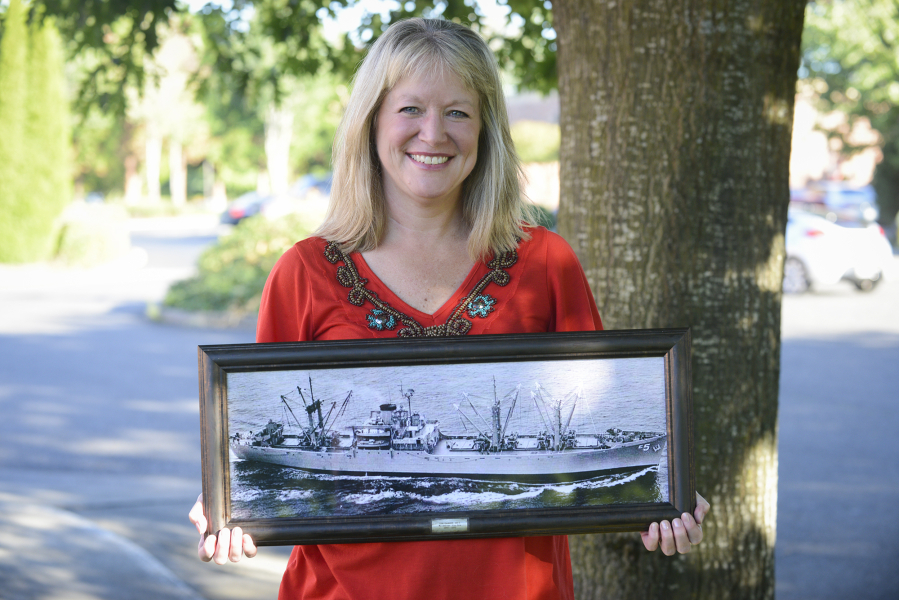Arnold Soukup was strong enough — and bold enough — to pick up a 250-pound bomb and drop it into the ocean.
But do you know what buckled the sailor’s knees? Needles.
That’s what Vancouver resident Ellen Townsen learned when she represented her dad a few days ago at a reunion of men who’d served on the USS Rainier. They gathered last week in Vancouver — almost within view of that namesake peak — to celebrate their ship’s record of service during three wars.
Clark County resident Lon Hannula served aboard the Rainier during the Vietnam War. Townsen stood in for her dad, who was part of the ship’s engine crew during the Korean War. He died about six weeks ago.
Larry Arseneau is another Clark County veteran who served aboard the USS Rainier. Ron Stimson of Longview was the reunion host.
Did You Know?
The USS Rainier was launched on March 1, 1941; it was decommissioned on April 30, 1946.
It was recommissioned on May 25, 1951, for Korean War service; it was decommissioned for the second and final time on Aug. 7, 1970.
Ninety-year-old reunion participant Charles Baymiller was aboard two other ammunition ships during World War II before serving on the Rainier during the Korean War.
Hannula joined the Navy after graduating from Battle Ground High School. He spent 2 1/2 years on the Rainier as part of the engine room crew.
While he was aboard, the ship was recognized several times for delivering ordnance and ammunition in some very challenging circumstances.
Transfers at 12 knots
It wasn’t just unloading crates onto a dock so another ship could haul them onboard. The Rainier and the warships it served were doing on-the-go transfers known as “unreps” — short for underway replenishments.
“We resupplied by cable,” Hannula said, with the ships doing 12 knots or so. “We were tied together for up to 24 hours, and nobody gets to sleep.”
The Rainier often was in the middle — literally — of two different resupplies at the same time. Sailing between two other ships, it could be transferring bombs to an aircraft carrier on one side, while sending deck-gun ammunition to a destroyer on the other side.
Those deliveries didn’t stop because of rough seas. Hannula recalled watching as “waves were breaking over the bow of the aircraft carrier, which was 75 feet in the air.”
Just imagine what it was like to be aboard a much smaller ship such as a destroyer in those conditions. That’s when men aboard the Rainier referred to destroyers as submarines, “because they were under water so much,” Hannula said.
“That is so true,” said a local Navy veteran who saw those transfers from the other side of the supply line. Ron Carr was an officer aboard the destroyer USS Richard B. Anderson, and had plenty of experience “driving the ship” during heavy-weather resupplies.
“I recall taking waves over the flying bridge and disappearing into the green sea. Fortunately, after three to five seconds, we broke through the other side and surfaced,” Carr said.
After one memorable three-hour stint keeping his destroyer steady as it took on supplies, “I went into the bridge to warm up. I couldn’t get my face to relax,” Carr said. “It was like it was frozen in place.”
One of the Rainier’s notable deliveries in 1969 was a transfer of about 950 tons of ordnance to the USS Camden. The Rainier’s crew worked for 38 straight hours, took a five-hour sleep break, then went back to work for 19 straight hours.
Dad’s shipmates share
Townsen learned about the Rainier crew reunion in Vancouver because of her dad’s death in Lisbon, Iowa. Soukup died Aug. 1. As Townsen and her siblings were going through his house, she found a newsletter with details about the 2016 reunion.
Townsen told herself: “I’m going to crash it!”
As a result, she learned a couple of things about her dad from his old shipmates.
“A 250-pound bomb fell from the deck into a hold.” Even though it wasn’t combat-ready, “Everybody froze, because it was unstable. Dad put it on his shoulder and dumped it in the water.”
Townsen also learned that her dad “would pass out while he was getting a shot,” she said. “Men would get on either side of him and hold him up.”
Hannula recalled another sailor’s reaction when a cable hoisting a bomb up to the deck snapped and the bomb plunged back into the hold.
“He plugged his ears.” Hannula said.
If the free-falling bomb had exploded on impact, Hannula wondered, “What difference would plugging his ears make?”




